Fresh salad is a recommended mainstay of healthy eating. But, salad can get expensive. Lettuce seeds, however, are cheap. You can grow lettuce, throughout the year, even if you don’t have a garden with one of these three indoor techniques.
If you’re new to indoor gardening, lettuce or herbs are great plants to start with. Herbs, because a small amount is all you need for a meal and there are lots of potted herbs for sale. Lettuce, because you can start it from seed and it’ll keep coming back for many month’s of salad harvests. Even better, there are a ton of different lettuce varieties, in different colors, available too. So salads don’t have to be green and bland when you grow lettuce yourself.

In this article, we are covering three different, indoor growing methods to grow lettuce. Each technique has a discussion of the tools and materials needed, and it’s benefits and ease or difficulty of set-up. If these methods seem difficult, there are always microgreens, and sprouts, that can also help keep your salad bowl full throughout the year. Whether you grow lettuce, or sprouts, or microgreens, all can add tasty nutrition to salads, sandwiches, and all your meals throughout the year.
First off, make sure you have some lettuce seeds. A quick look at Richter’s herbs, reveals 12 different lettuce varieties from speckled to red, and from smooth leaved to oak-leaf varieties. Other seed companies, especially those specializing in heirloom varieties, will have similar ranges of lettuces. Even a 1$ package of green lettuce from the dollar store, or hardware store, can work to get started with.
There is more than on type of lettuce, with indoor growing leaf lettuce often works best. It works for cut-and-come again techniques better than head lettuce. But, you can grow either, or both. With indoor growing, you don’t have to worry about bolting. However, indoor grown lettuce can become bitter over time, I like refreshing my indoor lettuce grows about every 2-3 months.

Grow Lettuce in Soil:
This is a variation of indoor container gardening, with soil as your base medium for the plants. This is how most indoor herbs, flowers, and veggies are grown, or how you’d grow lettuce outdoors if using the container gardening method. This method is comfortable and often familiar if you’ve done seed starting or any type of gardening before. With indoor growing you don’t need to worry about compost, mulch, or weeds.
For this growing method, you will need:
- A very sunny south facing window, or a grow light.
- A 2-3 inch deep planter or growing container.
- Vegetable oriented potting soil, organic preferred.
- Lettuce seeds of your chosen variety, or a salad mix of seeds.
- A spray bottle
- A drip tray that fits the planter
- Cinnamon (optional)
What to Do:
Start with filling the planter with fresh potting soil. While most potting soil is “ready to use” and already damp, I like watering it a bit more, to let it settle. Make sure the drainage holes are clear.
Once the soil is dampened down and slightly settled, it should be 1/2 – 1 inch from the top of the planter or container.
Sprinkle the lettuce seeds, by hand, over the top of the soil. Aim for an even spread when you sow seeds.
Sprinkle a bit of loose soil over the top of the seeds. A light, even, layer is best. Don’t compact this layer down, it’s to hold moisture over the seeds for germination.
Finally, sprinkle cinnamon over the top of the soil itself. This helps prevent fungal growth, prevents mold, and helps prevent damping off disease. It can also help confuse indoor pests like white flies, and fungus gnats.
Cover the planter with cling wrap, or a humidity dome. This helps maintain ideal moisture levels for seed germination. Place under a grow light, but keep out of direct sun for now. Save your seed packets, particularly if there’s still seed in them!
Lettuce germinates in 3-7 days. Once the seed leaves appear, remove the cling wrap.
Keep your growing lettuce planter under grow lights. If using natural light, you can now place the planter in direct sun.
Water the planter whenever the soil has dried out to 1/2 inch, especially in the early growing stages before roots are deep. Water from the bottom, by placing the planter in a sink or shallow tray of water and letting it soak it up.
Let the lettuce grow until it is about 3 inches tall. By hand, pinch the largest leaves from the outside of the individual lettuce plants. Or, using scissors, cut a small section leaving 1/2 inch above soil to regrow.

A soil based planter will let you harvest lettuce approximately 1-2 times per week, depending on it’s size. The lettuce should take one week or less to re-grow.
After the second or third harvest, water with a diluted solution of seaweed fertilizer or other organic, food safe, fertilizer to encourage sustained re-growth. Only add additional fertilizer once every two-three weeks, preferably a liquid form, not manure. You do not want to over fertilize. lettuce doesn’t need much extra nutrients.
If desired, when it’s time to plant outdoors, you can use these seedlings as transplants. This particularly works well for head type lettuces, like butterhead, buttercrunch, romaine lettuces, and other crisphead lettuce types. I prefer avoiding iceberg lettuce, as it’s lower in nutrition than loose-leaf lettuce, red leaf types, or oak leaf types.

Grow Lettuce with Aeroponics:
Aeroponics are an active, water based system, usually with either an airstone or a pump to move water around and trap air for the plant roots. You may have heard of an aerogarden, which is a convenient all-in-one aeroponic system. So far I haven’t noticed a difference in flavor for aeroponically grown lettuce, versus soil grown indoors. However, the aeroponic and kratky systems do seem to have faster re-growth than the standard soil base method.
For this growing method, you will need:
- An aeroponic system, either purchased or homemade.
- An Aeroponic or hydroponic specific nutrient solution
- Lettuce seeds
You can build your own aeroponic system.
- Hydroponic plant baskets
- Coconut coir or hydroponic pebbles
- An air stone or water pump
- A dark colored tote

What to Do:
If you’re going to build your own aeroponic system, start with cutting holes in the tote lid that will fit your hydroponic plant baskets.
Fill the baskets with pebbles or coir, and add one or two seeds to each (if head lettuce), sprinkle a pinch of seeds if planning to do cut and come again harvesting method.
Fill the tote until the bottom of the planting baskets are in the water. Add nutrients to the water, and set up an airstone or pump.
Lightly cover the top of your tub system with a clear humidity dome. This can be clear clamshells, cups, or even cling wrap. It’s just to keep humidity around the seeds so that they can germinate happily.
With this method, it may be easier to take soil started lettuce seedlings, wash the dirt off the roots, and transfer them to the pebble medium, so that the roots are already established and can reach the water already.
If working with a pre-built system:
Prepare system according to directions. For mine, that’s filling it with water and adding nutrients.
Then prepping the seedling baskets with sponges, and adding 1 or 2 seeds per basket.
Setting the baskets in their spots, and adding some “light reduction” stickies made from extra labels I have lying around.
Then adding the mini humidity domes to encourage germination.
Finally, programing the pre-built system for light timing, and fertilization reminders. And ignoring it until I either need to feed it, or I see germination and have to remove the little humidity domes.
This method gave me enough lettuce for a sandwich within 7 days from planting the seeds. By 14 days, I was getting a sandwich’s worth of lettuce every second day from just two lettuce “baskets.” It wasn’t even all 6 possible spots, and I was just harvesting the outer leaves.
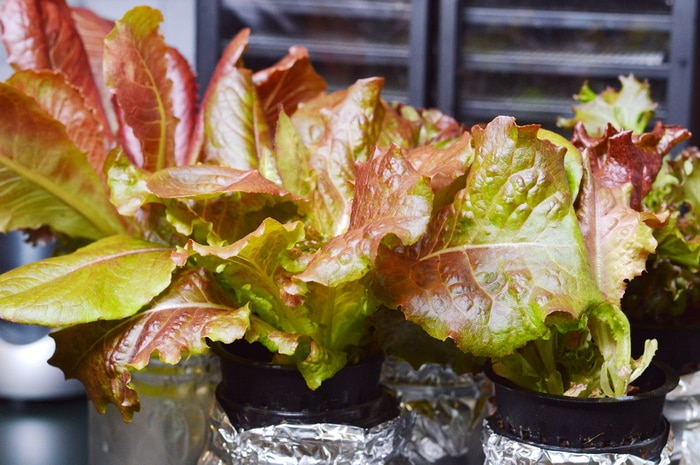
Grow Lettuce with the Kratky Method:
This is a passive hydroponic style system that doesn’t need a pump or an airstone. It’s super easy to set up, so if you don’t want the expense or hassle of a aeroponic system, this is a great alternative that is more vigorous than soil growing.
For this growing method, you will need:
- Hydroponic plant baskets
- Coconut coir
- wide mouthed jar(s), pint sized
- foil to cover jars
- lettuce seeds
- hydroponic nutrient solution
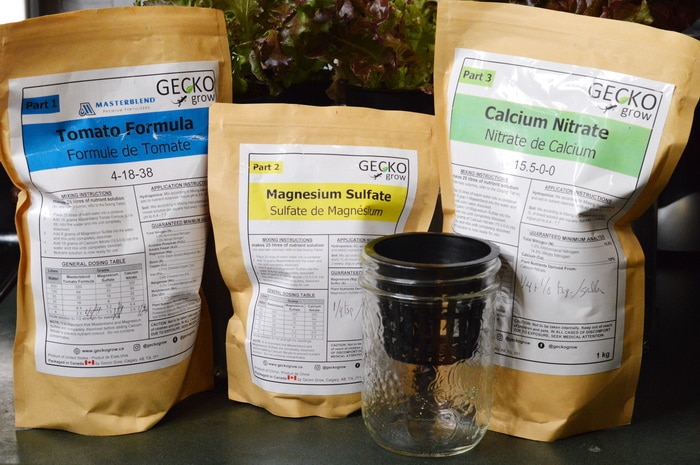
What to Do:
Start with setting up a plant basket with coconut coir. The coir absorbs water and helps keep the seeds happy while waiting for roots to grow. You can also use a pool noodle.
Set up a pint jar with water and nutrient solution. Fill so that it can reach the base of the coconut coir filled basket.
Let the basket absorb water and nutrient solution, top up with plain water as needed during this absorption process.
Plant 2-5 seeds per basket.
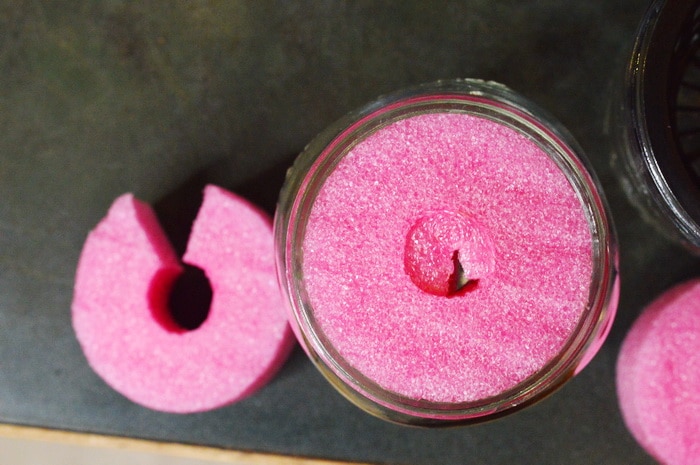
Place jar and basket contraption on a shelf under a grow light. Cover the base of the jar with foil, dark paper, or something else to block the light.
I would avoid putting a kratky jar on the windowsill or in direct sunlight, as the heat may concentrate enough to kill the seedlings.
Monitor the basket while waiting for germination, and top up with plain water if the water level drops too low. Once seeds germinate, it will take 1-1.5 weeks for “air roots” to form, and for feeder roots to drop down into the nutrient solution. Once that happens, the growth will take off and you will have plenty of lettuce to harvest.
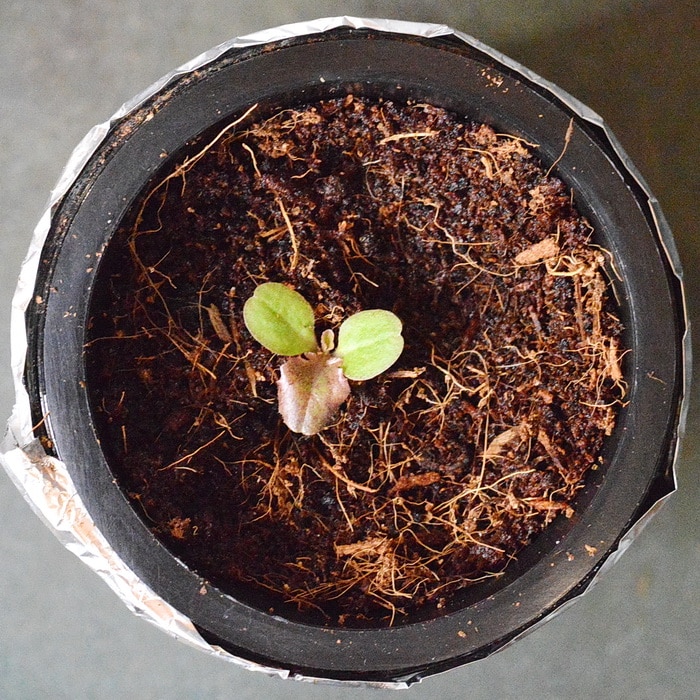
About every 2-3 weeks, you can add a bit more nutrient solution to the water being added to the kratky jar. The rest of the time, if it needs topping up, just add plain water so that the plants don’t get fertilizer burn.
The kratky method is a great way to test and try different types of lettuce, before deciding to plant them in an outdoor garden, or commit to a lot of plants. You can also use this method for spinach, tomatoes, peppers, and many other plants.
The below picture shows the root structure from the kratky system, and the air roots the plants form.
Other Things to Consider:
Plants started indoors, either in soil, or in an aeroponic or kratky system, can always be planted outdoors. Plants in an aeroponic or kratky system should be transferred to potting mix for a week or two, before being hardened off for outside planting. Lettuce can be hardened off and planted outdoors before your region’s last frost date.
Early spring plantings of lettuce can be in full sun, and semi-protected from frost by row covers if needed. Sun protection, if you get warm fast, may be needed. Afternoon shade is a good thing for extending the spring outdoor lettuce harvest.
In fall, any time after August, you can plant more lettuce to avoid the hot weather and prevent bolting. Fall lettuce can be extended outdoors with row covers as well.
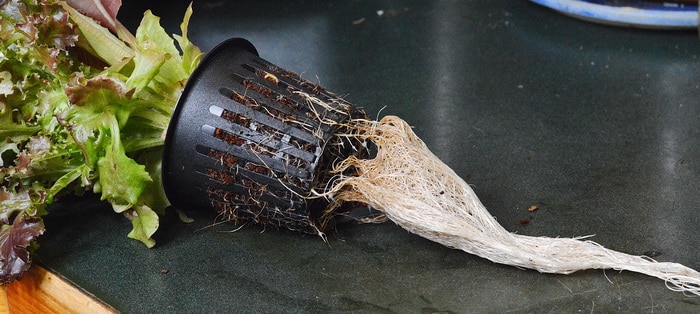
Indoor and Outdoor Pests:
When you grow lettuce indoors, you avoid most outdoor pests.However, indoor growing can have whitefly infestations and spider mites.
White-fly can be reduced with the use of yellow sticky traps. As well as vacuuming the adult flies as they fly around the plants. Fresh cinnamon, can also confuse the flies, when growing in soil, and prevent them from laying eggs again. However, if they get into an aeroponic system, the only way to eradicate them is dismantling it and completely scrubbing it down. Or, trapping the adults until there’s no further generations.
Spider mites have to be washed off the plants in question, either with a sponge with water and soap on it, or over the sink. Thankfully, with lettuce, the frequent harvests and re-growth make them less of a candidate for spider mites than other indoor plants, like sweet potato, eggplant, or tomatoes.
Outdoor lettuce pests include aphids, slugs, snails, and other insects.
Many outdoor pests, like aphids, can be avoided through companion planting. Lettuce is a fast crop, and can be inter planted with longer growing crops to help define rows. Lettuce does well planted alongside beets, onions, garlic, and chives. The strong scent of the alium family plants helps deter some flying pests.
Plants can be further protected from slugs and snails by a light layer of crushed eggshells sprinkled around the rows, or around the edges of the garden bed if growing in raised beds. The slugs and snails won’t cross the eggshells, as the eggshells cut them. Eventually, the eggshells will break down enough to add calcium to your soil too.
Personally, I like planting my outdoor lettuce alongside radishes, basil, parsley, and peas. Then, as they are thinned out for eating, I plant in some of my indoor started plants like tomatoes, peppers, and flowers.
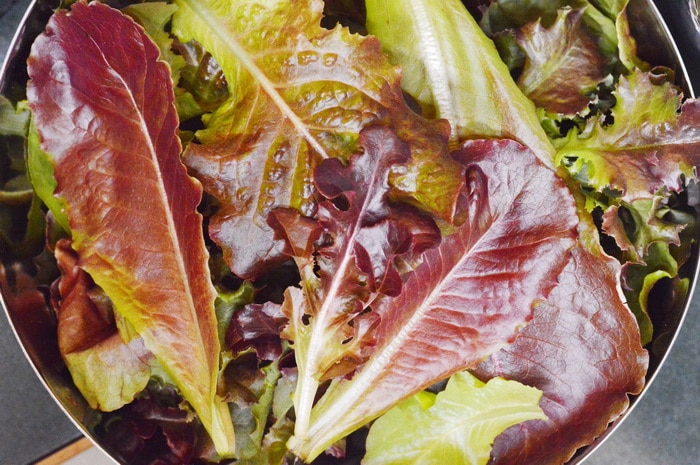
Grow Lettuce and More:
Many other plants do well with indoor growing. Try tomatoes, peppers, and other hot weather crops in indoor pots, or a kratky jar over the winter.
Indoor growing methods are great for letting cool plants thrive in summer, and hot weather loving plants grow in winter. There’s nothing quite like fresh tomato and basil caprise bites in mid-December, when you grew the tomatoes and basil yourself. It’s awesome to have sweet lettuce in August, when most lettuce have bolted because of heat, or spinach.
The aeroponic and kratky growing methods are also helpful to germinate hard-to-germinate seeds like lavender, rosemary, and other herbs. I’m even using the aeroponic growing method to help germinate pink banana seeds. There is really no limit to what you can sprout and grow indoors using one of these three methods.
Just make sure you have a sunny windowsill, or a good grow light, and plant away!


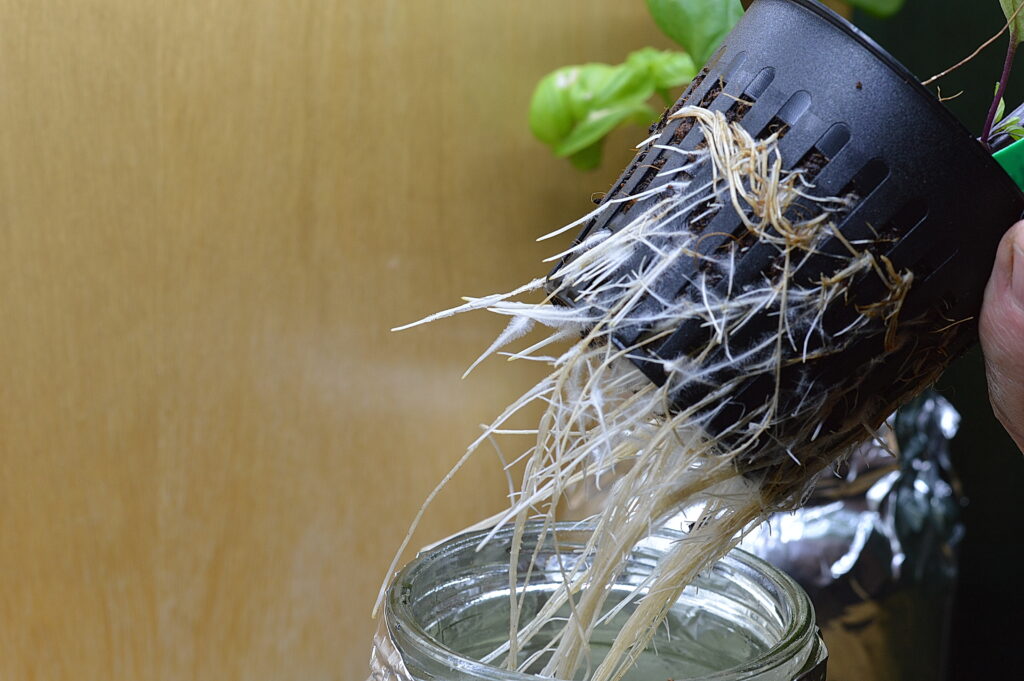

This was very helpful. starting a lettuce garden hopefully soon. With your information I think I will go with an aeroponic system. I live in the basement apartment and need the grow lights and a system that’s set up for me since I’m not great with a green thumb. thank you